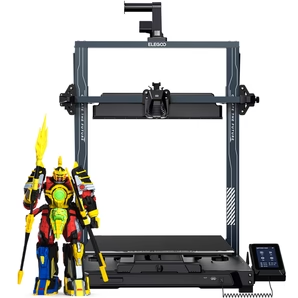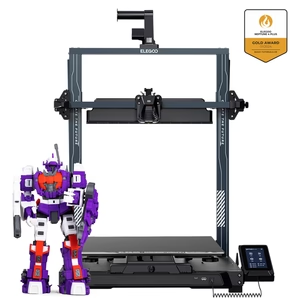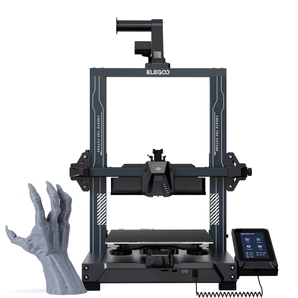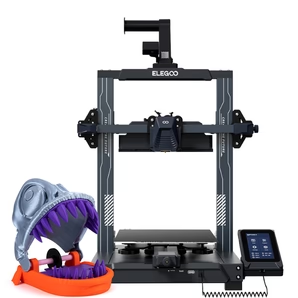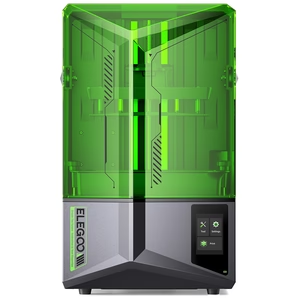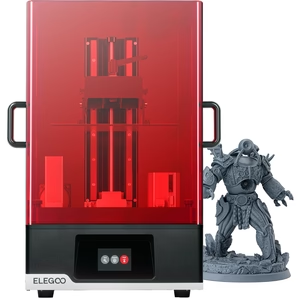Welcome to the impressively ever-expanding world of 3D-printed jewelry! This article will delve into the exciting world of 3D printing and how it's creating waves in the jewelry business.
Offering both professionals and enthusiasts new design freedom, this innovative technology is setting new standards in jewelry manufacturing.
You'll understand why investing time to read this article is worth it as we unravel the applications, advantages, and remarkable creativity that 3D printing for jewelry has unlocked.
There's no doubt that the popularity of making your own jewelry continues to be one of the more popular 3D Printing Projects that we see year-on-year. Let's dive in and see why!
Article Outline
- Introduction to 3D Printing in Jewelry
- 3D Printers for Jewelry: What Are They and How Do They Work?
- How Is 3D Printed Jewelry Designed?
- The Process: From 3D Modeling to Wax Casting
- Benefits of Using 3D Printing in Jewelry Manufacturing
- Custom Jewelry and Design Freedom: The Future of Jewelry?
- 3D Printing vs Traditional Techniques in Jewelry Making
- Unleashing Creativity: Examples of Impressive 3D Printed Jewelry
- The Impact of 3D Printing on the Jewelry Business
- Future Trends and Prospects in 3D Printing for Jewelry
Introduction to 3D Printing in Jewelry
3D printing, also known as additive manufacturing, has been a game-changer across multiple industries, including the world of jewelry.
It has revolutionized the process of jewelry production, enabling designers to create pieces with complex geometries that would be difficult or even impossible with traditional manufacturing methods.
Thanks to 3D printing, designers now have the freedom to create stunning 3D printed jewelry without the constraints of conventional jewelry-making techniques.
3D Printers for Jewelry: What Are They and How Do They Work?
A 3D resin printer for jewelry are specialized machines that create detailed, precise models for casting and molding. They work by using a digital file to print layer upon layer of material (commonly castable resin) to create a three-dimensional object.
These printers are incredibly precise, making them perfect for creating intricate, detailed jewelry designs.
The wax or resin 3D printer transforms a digital CAD design into a physical wax pattern, ready for the traditional lost wax casting process.
How Is 3D Printed Jewelry Designed?
The first step in creating 3D-printed jewelry involves designing the piece using specialized CAD software. The design is then converted into a format that the 3D printer can understand.
The printer then builds the jewelry piece layer by layer from the bottom up. After the printing process, the piece undergoes post-processing, which includes curing and surface finish treatments, to ensure a smooth surface and superior surface finish.
The Process: From 3D Modeling to Wax Casting
After the jewelry piece is designed using CAD software, the 3D printer prints the design using a castable material such as wax or resin. This printed model serves as a prototype, which can be used to inspect the design's geometry before proceeding with the final manufacturing process.
The 3D-printed patterns are then used in the traditional lost-wax casting process. This involves creating a mold around the 3D-printed jewelry models, which is then heated to melt and remove the wax, leaving a hollow mold. Molten precious metals like gold are then poured into this mold to create the jewelry piece.
Benefits of Using 3D Printing in Jewelry Manufacturing
3D printing technology provides a myriad of benefits in jewelry manufacturing. It allows for the creation of complex designs and custom jewelry that would be difficult to achieve with traditional methods.
With the ability to create a prototype before the final piece, it reduces waste and saves on material costs. Moreover, 3D printing speeds up the production process, allowing jewelers to respond more quickly to market trends and customer demands.
Custom Jewelry and Design Freedom: The Future of Jewelry?
Custom jewelry is an emerging trend in the jewelry industry, and 3D printing technology is at the heart of it. With 3D printing, customers can get involved in the design process, creating a personal connection to the piece and a truly unique product.
3D printing technology provides designers with an unprecedented level of design freedom, allowing them to create jewelry with complex geometries and intricate details.
3D Printing vs Traditional Techniques in Jewelry Making
While traditional techniques in jewelry making continue to be important, 3D printing offers several advantages. It simplifies the process of making intricate and detailed pieces, and it speeds up production, allowing designers to go from concept to physical product faster.
It also offers an economical solution for producing custom pieces and small batch runs, and it reduces waste by creating less material during the manufacturing process.
Unleashing Creativity: Examples of Impressive 3D Printed Jewelry
One of the most popular jewelry accessories we see being printed are earrings. One of the things we absolutely love about 3D printed earrings is the level of customization; they really can be designed entirely to your taste, and furthermore, you can even tailor them to specific outfits.
Indeed!
Matching 3D printed earrings with your OOTD! Also - another point about earrings is this: they make fantastic gifts!
The Impact of 3D Printing on the Jewelry Business
The impact of 3D printing on the jewelry business is significant. It has transformed the way jewelry is designed, prototyped, and produced, enabling rapid manufacturing and customization. It's also opened up a new world of possibilities in terms of design and personalization, setting new standards in the jewelry industry.
Future Trends and Prospects in 3D Printing for Jewelry
The future of 3D printing for jewelry looks promising. As the technology continues to evolve and become more accessible, it's expected that more and more jewelry designers and manufacturers will adopt this technique. We will likely see more complex and intricate designs, faster production times, and even more customization options in the future.
Key Points to Remember:
- 3D printing technology has revolutionized the jewelry design and manufacturing process.
- It offers unparalleled design freedom, allowing for the creation of intricate and complex pieces.
- It provides an economical solution for creating custom jewelry and small batch runs.
- The technology continues to evolve and is setting new standards in the jewelry industry.
- 3D printed jewelry is not only impressive but also opens up a new world of possibilities in terms of design and personalization.
Other Project Ideas To Explore
The fascinating universe of 3D printing now encompasses hundreds of use-cases. One of our favorite uses includes board game projects that enhance the joy of tabletop gaming. Enthusiasts are perfecting the craft of diorama projects, while the cosplay world flourishes with unparalleled costume accessories. Simultaneously, jewelry designers explore newfound intricacies.
3D printing's practical utility shines in superior DIY home projects, introducing specialized garden tools that are both functional and aesthetic. The best toy projects stand as a testament to the blend of recreation and learning. dentistry, a field that demands precision, is capitalizing on the technology's benefits. Furthermore, the breakthroughs in producing braille materials through 3D printing herald a new age of accessibility. 3D sports printing enthusiasts too, have reasons to cheer with equipment tailored to their exact needs.
Still Need More Info Relating to 3D Jewelry Printing?
Check Out Some Common Questions We Recieve:
Can You 3D Print A Ring?
» Show Me The Replies
Here are some answers:
- Yes, 3D printing technology can be used to create rings
- 3D printing allows for customized and unique designs
- The process involves creating a 3D digital model and then using a 3D printer to bring it to life in physical form
- There are various materials that can be used for 3D printing rings, including metal, plastic, and even wood
How To Cast 3D Printed Jewelry?
» Show Me The Replies
Here are some answers:
- Create a 3D model of the jewelry design using 3D modeling software
- Convert the 3D model into a 3D printable file format, such as STL or OBJ
- Prepare the 3D printer by checking the settings and loading the appropriate material
- Print the jewelry using the 3D printer, making sure to use a high-resolution setting for fine details
How To 3D Print Jewelry Molds?
» Show Me The Replies
Here are some answers:
- Design or find a 3D model of the jewelry mold
- Prepare the 3D model for 3D printing
- Choose the appropriate 3D printing material for the mold
- Use a 3D printer to print the mold
Can You 3D Print Gold?
» Show Me The Replies
Here are some answers:
- Yes, it is possible to 3D print gold
- Incorporating gold powder into the printing material can produce 3D printed gold objects
- Gold 3D printing is achieved through a process called Direct Metal Laser Sintering
- 3D printed gold objects can have intricate and complex designs
3D Printed Toy Jewelry?
» Show Me The Replies
Here are some answers:
- Can be customized to unique designs
- Can be made with durable materials
- Can be made in a variety of colors
- Can be printed quickly and easily
3D Print a Jewelry Box?
» Show Me The Replies
Here are some answers:
- Design a 3D model of the jewelry box on a computer
- Choose the appropriate material for printing
- Preheat the 3D printer and load the selected material
- Press the print button and wait for the box to be printed
3D Printing In Jewellery Industry
» Show Me The Replies
Here are some answers:
- Increased design possibilities
- Faster turnaround time
- Cost-effective production
- Personalized/customized designs
How To Make 3D Printed Earrings?
» Show Me The Replies
Here are some answers:
- Choose a design for your earrings
- Create a digital 3D model using CAD software
- Export the 3D model as an STL file
- Prepare your 3D printer and load the filament
3D Printing Jewelry Necklace
» Show Me The Replies
Here are some answers:
- Uses additive manufacturing process to create intricate designs
- Can use various materials such as metal, plastic, or resin
- Allows for customization and unique, one-of-a-kind pieces
- Offers fast production and turnaround time



















